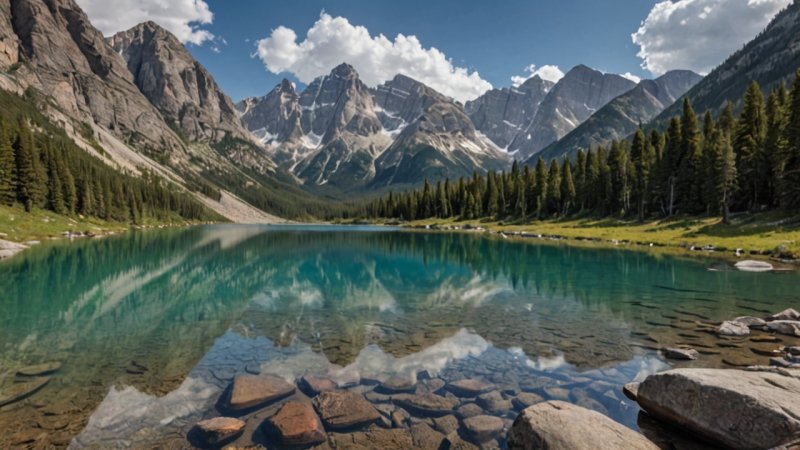The Rocky Mountains, often referred to as the Rockies, stretch over 3,000 miles from Canada down to the southwestern United States. This magnificent range is not only one of the most recognizable mountain systems in the world but also offers some of the most diverse and breathtaking landscapes on the planet. From soaring peaks and alpine lakes to lush valleys and expansive forests, the Rockies are a treasure trove of natural beauty waiting to be explored. In this article, we will delve into the unique landscapes of the Rocky Mountains, highlight key destinations, and provide travel tips to ensure you make the most of your adventure in this stunning region.
Geological Wonders of the Rockies
The Rocky Mountains were formed over millions of years through a combination of tectonic uplift and erosion. The result is a dramatic topography featuring rugged peaks, deep canyons, and glacial valleys. Key geological features include:
- Granite Peaks: The Rockies are home to some of the tallest granite peaks in North America, including Mount Elbert in Colorado, which rises to 14,440 feet.
- Glacial Valleys: The effects of glaciation have carved out U-shaped valleys, such as Glacier National Park's famous Going-to-the-Sun Road, offering breathtaking views.
- Unique Rock Formations: The stunning red rock formations in Colorado’s Garden of the Gods contrast beautifully with the surrounding greenery.
Ecological Diversity
The Rocky Mountains boast a wide range of ecosystems, from arid desert landscapes to lush temperate rainforests. These ecosystems support a rich biodiversity, making the Rockies a haven for wildlife enthusiasts. Some key ecological zones include:
Montane Zone
Located at lower elevations, the montane zone is characterized by coniferous forests and abundant wildlife. Animals such as deer, elk, and a variety of birds can be spotted here.
Subalpine Zone
This zone is marked by cooler temperatures and shorter growing seasons. It features alpine meadows filled with wildflowers and is home to species like mountain goats and marmots.
Alpine Zone
At the highest elevations, the alpine zone showcases stunning vistas and harsh conditions. The vegetation here consists mainly of hardy shrubs and grasses, and wildlife is scarce but includes species such as pikas and snowshoe hares.
Must-Visit National Parks
The Rocky Mountains are home to several national parks that offer unique landscapes and outdoor experiences. Here are some of the must-visit parks:
1. Rocky Mountain National Park, Colorado
This park is renowned for its stunning mountain vistas, alpine lakes, and diverse wildlife. Key highlights include:
- Trail Ridge Road: One of the highest paved roads in North America, offering panoramic views and access to various trailheads.
- Bear Lake: A picturesque glacial lake with easy access and stunning views of the surrounding peaks.
- Wildlife Watching: The park is home to elk, moose, and black bears, making it a prime destination for wildlife enthusiasts.
2. Glacier National Park, Montana
Known for its dramatic landscapes and rich biodiversity, Glacier National Park offers a variety of outdoor activities. Key features include:
- Going-to-the-Sun Road: An engineering marvel that provides access to the heart of the park, with breathtaking views along the way.
- Hiking Trails: Over 700 miles of trails, including the famous Highline Trail, which offers breathtaking views of the park's rugged terrain.
- Glacial Lakes: The park is dotted with stunning turquoise lakes, including Lake McDonald and St. Mary Lake.
3. Banff National Park, Alberta, Canada
Banff is Canada’s first national park and is famous for its breathtaking mountain scenery and outdoor activities. Highlights include:
- Lakes Louise and Moraine: These iconic glacial lakes are known for their stunning emerald colors and surrounding mountain peaks.
- Banff Townsite: A charming mountain town with shops, restaurants, and stunning views of the surrounding landscape.
- Wildlife Viewing: The park is home to a variety of wildlife, including grizzly bears, wolves, and bighorn sheep.
Unique Experiences in the Rockies
The Rockies offer a plethora of unique experiences that go beyond the typical hiking and sightseeing. Here are some noteworthy activities to consider:
1. Hot Springs
Relaxing in natural hot springs surrounded by mountain views is a must-do experience in the Rockies. Notable hot springs include:
- Banff Upper Hot Springs: Located in Banff National Park, these hot springs offer stunning views of the surrounding mountains.
- Pagosa Springs: Known for its healing mineral-rich waters, this Colorado destination features numerous hot springs resorts.
2. Scenic Drives
The Rockies are home to some of the most scenic drives in North America. Consider exploring:
- Icefields Parkway: A breathtaking drive between Jasper and Banff, offering stunning views of glaciers, lakes, and valleys.
- Trail Ridge Road: This road in Rocky Mountain National Park provides access to high-altitude scenery and numerous overlooks.
3. Winter Sports
The Rockies transform into a winter wonderland, offering a variety of snow sports. Some popular winter activities include:
- Skiing and Snowboarding: Resorts like Vail, Aspen, and Whistler provide world-class skiing and snowboarding opportunities.
- Snowshoeing: Many parks offer snowshoeing trails that allow visitors to explore the winter landscape.
- Ice Climbing: For the adventurous, ice climbing in places like Ouray, Colorado, offers a unique challenge.
Travel Tips for the Rockies
When planning your trip to the Rocky Mountains, consider the following tips to enhance your experience:
- Best Time to Visit: The summer months (June to September) offer the best hiking conditions, while winter (December to March) is ideal for snow sports.
- Acclimatize: If you're coming from lower elevations, give your body time to adjust to the higher altitudes to avoid altitude sickness.
- Pack Accordingly: Layers are essential in the Rockies; temperatures can vary significantly throughout the day.
- Stay Hydrated: The high altitude can cause dehydration, so drink plenty of water while exploring.
Conclusion
The Rocky Mountains represent one of the most spectacular natural landscapes in the world, offering a unique blend of geological wonders, ecological diversity, and breathtaking beauty. Whether you are hiking through national parks, relaxing in hot springs, or hitting the slopes during winter, the Rockies provide endless opportunities for exploration and adventure. With thoughtful planning and an adventurous spirit, your journey through the Rocky Mountains will surely be an unforgettable experience.






